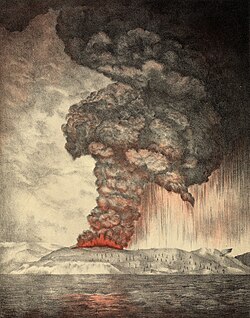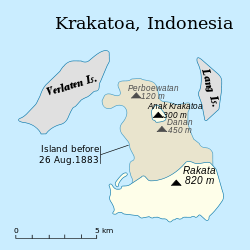
Read and learn about history, pick out a good one for us!
https://en.wikipedia.org/wiki/May_20
1883 – Krakatoa begins to erupt; the volcano explodes three months later, killing more than 36,000 people.
1983 – First publications of the discovery of the HIV virus that causes AIDS in the journal Science by Luc Montagnier.
2013 – An EF5 tornado strikes the Oklahoma City suburb of Moore, killing 24 people and injuring 377 others.
https://en.wikipedia.org/wiki/1883_eruption_of_Krakatoa
| 1883 eruption of Krakatoa | |
|---|---|
 Lithograph of the eruption c. 1888 Lithograph of the eruption c. 1888 | |
| Volcano | Krakatoa |
| Start date | 26 August 1883 |
| End date | 27 August 1883 |
| Type | Ultra-Plinian |
| Location | Krakatoa archipelago, Sunda Strait Coordinates:  6.102°S 105.423°E 6.102°S 105.423°E |
| VEI | 6 |
| Impact | 20 million tons of sulfur released; five-year drop of 1.2 °C (2.2 °F) |
| Deaths | 36,417 |
 The change in geography after the eruption The change in geography after the eruption | |
The 1883 eruption of Krakatoa (Indonesian: Letusan Krakatau 1883 ) in the Sunda Strait began on the afternoon of Sunday, 26 August 1883—with origins as early as that May—and peaked on the late morning of Monday, 27 August 1883, when over 70% of the island of Krakatoa and its surrounding archipelago were destroyed as it collapsed into a caldera.
The eruption was one of the deadliest and most destructive volcanic events in recorded history and explosions were so violent that they were heard 3,110 kilometres (1,930 mi) away in Perth, Western Australia, and Rodrigues near Mauritius, 4,800 kilometres (3,000 mi) away. At least 36,417 deaths are attributed to the eruption and the tsunamis it created.
Significant additional effects were also felt around the world in the days and weeks after the volcano's eruption. Additional seismic activity continued until February 1884; reports of seismic activity after October 1883 were later dismissed by Rogier Verbeek's investigation into the eruption.
In the year following the eruption, average Northern Hemisphere summer temperatures fell by 0.4 °C (0.72 °F).[13] The record rainfall that hit Southern California during the water year from July 1883 to June 1884 – Los Angeles received 970 millimetres (38.18 in) and San Diego 660 millimetres (25.97 in)[14] – has been attributed to the Krakatoa eruption.[15] There was no El Niño during that period as is normal when heavy rain occurs in Southern California,[16] but many scientists doubt that there was a causal relationship.[17][failed verification]
The eruption injected an unusually large amount of sulfur dioxide (SO2) gas high into the stratosphere, which was subsequently transported by high-level winds all over the planet. This led to a global increase in sulfuric acid (H2SO4) concentration in high-level cirrus clouds. The resulting increase in cloud reflectivity (or albedo) reflected more incoming light from the sun than usual, and cooled the entire planet until the sulfur fell to the ground as acid precipitation.[18]
1888 paintings, showcasing the optical effects of the eruption on the sky over time
The 1883 Krakatoa eruption darkened the sky worldwide for years afterwards and produced spectacular sunsets throughout the world for many months. British artist William Ashcroft made thousands of colour sketches of the red sunsets halfway around the world from Krakatoa in the years after the eruption. The ash caused "such vivid red sunsets that fire engines were called out in New York, Poughkeepsie, and New Haven to quench the apparent conflagration."[19] This eruption also produced a Bishop's Ring around the sun by day, and a volcanic purple light at twilight. In 2004, an astronomer proposed the idea that the red sky shown in Edvard Munch's 1893 painting The Scream is also an accurate depiction of the sky over Norway after the eruption.[20]
https://www.youtube.com/watch?v=3iCJL9dYZK8